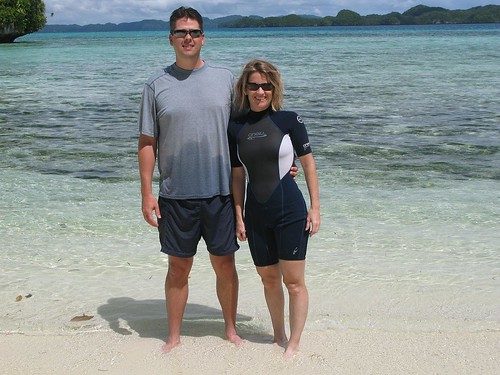
Our first day here was an excursion out into the beautiful Phang Na Bay on a local “long-tail" boat. The entire bay is filled with islands: If the Rock islands of Palau were shaped like giant mushrooms, these islands are like tall gumdrops. They are scattered randomly around the bay, and rise straight up to one thousand feet high above the water, with vertical limestone walls. Everywhere there were natural arches and sea caves, with impossibly contorted stalactites hanging down.
We were surprised to learn that the kayaking portion of our day trip would be powered by a local... in the kayak with us. So instead of getting some exercise, we had a “ride” around some of the sea caves – while listening to our paddler proudly repeating the phrase “Barak Obama, Barack Obama” - perhaps the only English he knew. Speaking of Obama, most all the locals we meet (Palau, Philippines, Singapore, Thailand) mention him with great enthusiasm. The world seems very optimistic about a new posture of diplomacy and cooperation from the United States. We got to watch the inauguration speech on a stuttering video stream by the pool here in Khao Lak, Thailand. Inspirational, as always.
In case you have this romantic image of folks in Asia all riding around on bicycles, let me tell you that progress has arrived - and they all ride motor-scooters. Everyone. Young school girls, old ladies, even parents taking their children somewhere. They far outnumber automobiles (>10:1), and the only bicycles we've seen were tourists (almost). Some of the scooters have sidecars – some have sidecars with charcoal grills and ice chests built in to serve as a food service cart.
Walking back from dinner one night in the beach town of Khao Lak, there appeared a line of lights burning bright orange high in the sky above us. They obviously weren't planes or helicopters, but what else could they be? Was this the beginning of a massive UFO invasion? Or a battery of military rockets being launched? After a few puzzled minutes (with just a hint of apocalyptic uneasiness), a local told us they were rice paper lanterns lifted by the hot air of onboard wax candles – to carry people's wishes aloft - very beautiful once you understand it.
90 butt-numbing minutes on a rental moped ($8 for the day) took us to Khao Sok National Park. There we met “Too-Too,” the elephant who would carry us on a jungle walk. It was remarkable how large and powerful he was, carrying us through the jungle, up and down meter-high ledges in a very rough "trail" that no 4wd or horse could ever navigate. Riding the elephant is odd: First, there's the sensation of your bare feat are on his leathery skin with coarse hair, and you find yourself rocked back and forth quite a bit with each step he takes, and finally, when you sit on his neck (a truly special privilege), you find his head is oddly spongy. All very cool! There is a tight bond between the elephant and his handler, who carries only a long sharp stick (which we never saw him use). After years of "relationship-building," the handler can encourage the elephant to do what he wants, and rewards him with food and by washing him.
Next up, scuba diving from a live-aboard off the Similan islands...











